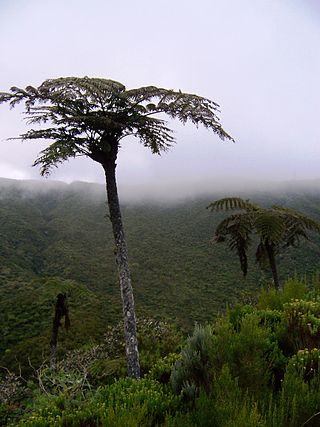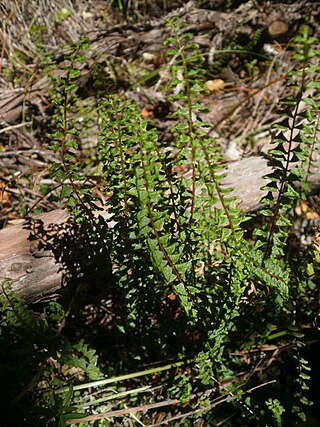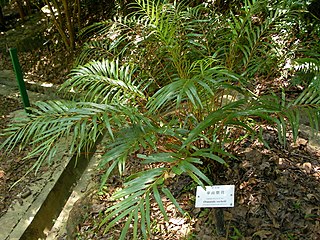
The Nymphaeales are an order of flowering plants, consisting of three families of aquatic plants, the Hydatellaceae, the Cabombaceae, and the Nymphaeaceae. It is one of the three orders of basal angiosperms, an early-diverging grade of flowering plants. At least 10 morphological characters unite the Nymphaeales. One of the traits is the absence of a vascular cambium, which is required to produce both xylem (wood) and phloem, which therefore are missing. Molecular synapomorphies are also known.

Thelypteridaceae is a family of about 900 species of ferns in the order Polypodiales. In the Pteridophyte Phylogeny Group classification of 2016, it is placed in the suborder Aspleniineae. Alternatively, the family may be submerged in a very broadly defined family Aspleniaceae as the subfamily Thelypteridoideae.

The order Cyatheales, which includes most tree ferns, is a taxonomic order of the fern class, Polypodiopsida. No clear morphological features characterize all of the Cyatheales, but DNA sequence data indicate the order is monophyletic. Some species in the Cyatheales have tree-like growth forms from a vertical rhizome, others have shorter or horizontal expanding rhizomes.

Dicksonia is a genus of tree ferns in the order Cyatheales. It is regarded as related to Cyathea, but is considered to retain more primitive traits, dating back at least to the Jurassic and Cretaceous periods. The fossil record includes stems, pinnules, and spores.

The Cyatheaceae are a family of ferns, the scaly tree ferns, one of eight families in the order Cyatheales in the Pteridophyte Phylogeny Group classification of 2016. Alternatively, the family may defined much more broadly as the only family in the Cyatheales, with the PPG I family treated as the subfamily Cyatheoideae. The narrower circumscription is used in this article.

Dicksoniaceae is a group of tropical, subtropical and warm temperate ferns, treated as a family in the Pteridophyte Phylogeny Group classification of 2016, and counting 30-40 species. Alternatively, the family may be sunk into a very broadly defined family Cyatheaceae sensu lato as the subfamily Dicksonioideae. Most of the genera in the family are terrestrial ferns or have very short trunks compared to tree ferns of the family Cyatheaceae sensu stricto. However, some of the larger species can reach several metres in height. A number of others are epiphytes. They are found mostly in tropical regions in the Southern Hemisphere, as far south as southern New Zealand. Larger tree ferns in the genus Cibotium were formerly included in Dicksoniaceae, but are now segregated as the family Cibotiaceae.

Claytosmunda is a genus of fern. It has only one extant species, Claytosmunda claytoniana, the interrupted fern, native to Eastern Asia, Eastern United States, and Eastern Canada.

Pteridaceae is a family of ferns in the order Polypodiales, including some 1150 known species in ca 45 genera, divided over five subfamilies. The family includes four groups of genera that are sometimes recognized as separate families: the adiantoid, cheilanthoid, pteridoid, and hemionitidoid ferns. Relationships among these groups remain unclear, and although some recent genetic analyses of the Pteridales suggest that neither the family Pteridaceae nor the major groups within it are all monophyletic, as yet these analyses are insufficiently comprehensive and robust to provide good support for a revision of the order at the family level.

Lindsaeaceae is a pantropical family of ferns in the order Polypodiales. It contains six or seven genera with about 220 known species, some of which also extend into the more temperate regions of eastern Asia, New Zealand, and South America.
Cystodium is a fern in its own family, Cystodiaceae. It contains a single species: Cystodium sorbifolium(Sm.) J.Sm. 1841. Because it looks like a small tree fern, it had previously been placed in the tree fern family Dicksoniaceae. Subsequent analysis had moved it to the Lindsaeaceae, but the most recent phylogenetic studies have placed it in its own separate family, Cystodiaceae, with a sister relationship to the current Lindsaeaceae. A fossil species of the genus Cystodium sorbifolioides is known from the Cenomanian aged Burmese amber in Myanmar.
This article records new taxa of plants that are scheduled to be described during the year 2017, as well as other significant discoveries and events related to paleobotany that are scheduled to occur in the year 2017.
This article records new taxa of plants that are scheduled to be described during the year 2018, as well as other significant discoveries and events related to paleobotany that occurred in the year 2018.
This article records new taxa of plants that were described during the year 2014, as well as other significant discoveries and events related to paleobotany that occurred in the year 2014.

Plenasium is a genus of ferns in the family Osmundaceae. It is recognized in the Pteridophyte Phylogeny Group classification of 2016 (PPG I), but kept within a more broadly circumscribed genus Osmunda by other sources. The genus is known from Early Cretaceous to present.
2019 in paleoentomology is a list of new fossil insect taxa that were described during the year 2019, as well as other significant discoveries and events related to paleoentomology that were scheduled to occur during the year.
This article records new taxa of fossil plants that are scheduled to be described during the year 2020, as well as other significant discoveries and events related to paleobotany that are scheduled to occur in the year 2020.
Burmese amber is fossil resin dating to the early Late Cretaceous Cenomanian age recovered from deposits in the Hukawng Valley of northern Myanmar. It is known for being one of the most diverse Cretaceous age amber paleobiotas, containing rich arthropod fossils, along with uncommon vertebrate fossils and even rare marine inclusions. A mostly complete list of all taxa described up until 2018 can be found in Ross 2018; its supplement Ross 2019b covers most of 2019.
2015 in paleoentomology is a list of new fossil insect taxa that were described during the year 2016, as well as other significant discoveries and events related to paleoentomology that were scheduled to occur during the year.

Coniopteris is an extinct genus of Mesozoic fern leaves. It was widespread over both hemispheres during the Jurassic and Early Cretaceous, with over 130 species having been described. While traditionally assumed to have been a member of Dicksoniaceae or a close relative of Thyrsopteris, a 2020 cladistic analysis found it to be a stem group of Polypodiales. Most species of Coniopteris probably had a herbaceous habit. Coniopteris laciniata had tufts of leaves sprouting from intervals of a thin, creeping rhizome. The genus is technically a junior synonym of the little used Polystichites, but was conserved by the ICZN in 2013. Some authors suggest a range of Early Jurassic-early Late Cretaceous for the genus, while others suggest a more expansive range spanning from the Middle Triassic to the Eocene.
Burmese amber is fossil resin dating to the early Late Cretaceous Cenomanian age recovered from deposits in the Hukawng Valley of northern Myanmar. It is known for being one of the most diverse Cretaceous age amber paleobiotas, containing rich arthropod fossils, along with uncommon vertebrate fossils and even rare marine inclusions. A mostly complete list of all taxa described up until 2018 can be found in Ross 2018; its supplement Ross 2019b covers most of 2019.











